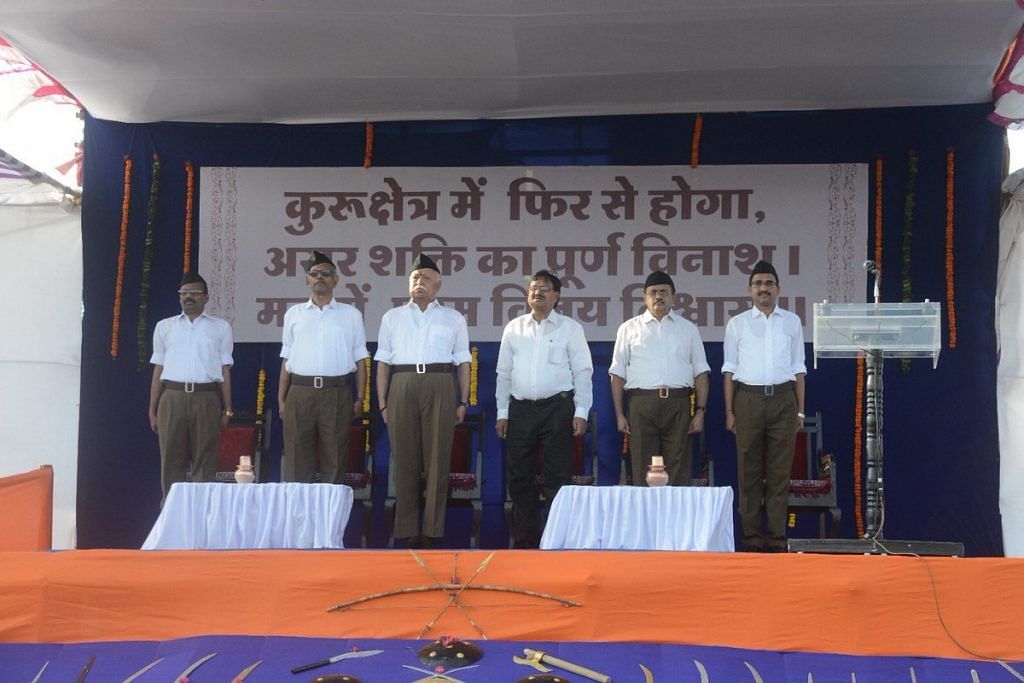Top RSS leaders avoid social media. But the organisation itself is well-versed in its use and has ‘checks & balances’, top leaders say.
New Delhi: The Rashtriya Swayamsevak Sangh is a bit of an enigma when it comes to its handling of social media. Yes, it has its official ‘verified’ page on Facebook and the @RSSorg handle on Twitter, but its top leaders mostly avoid the platforms, as well as conventional media, leading to a reputation of being ‘inaccessible’.
Earlier this month, Mohan Bhagwat, the all-powerful head of the socio-cultural organisation, said he would never open a personal Facebook or Twitter account, citing “social media’s potential to make users egotistical and self-centric”.
“Various services and facilities are useful, but they also have their nuisance value. Therefore, they must be used in a restrained way,” he said in an interview to Organiser. “Facebook, by its name itself, represents your face as an individual and, therefore, tends to make you more self-centric.”
And yet, last month, when Bhagwat stirred a hornet’s nest by saying that the “Indian Army would take six months to prepare the society (for a war-like situation), whereas swayamsevaks can be trained in three days as swayamsevaks practice discipline regularly”, the RSS’s publicity wing took to social media to combat opposition attacks. It posted a video and a statement on its Twitter handle, saying the comment had been misinterpreted; that it was not an insult to the army.
The RSS brass insists that this was the perfect demonstration that, contrary to its anti-modern and ‘inaccessible’ reputation, the Sangh is well-versed with social media. The only difference, leaders say, is that the RSS maintains checks and balances on its use of social media.
Manmohan Vaidya, the all-India Sah-Sarkaryavah of the RSS and previously its prachar pramukh, said this controlled strategy is far from being ‘inaccessible’. “If I miss your call, I will call back. This is our work culture,” he said.
However, given social media’s propensity to turn casual comments into mudslinging matches, Vaidya said this control is necessary as “malicious allegations don’t serve the nation’s interests”.
“The Sangh believes that if anything needs a reaction, we respond without getting into arguments. The RSS does not counter every allegation. We leave many issues unaddressed, as most are not worth reacting to,” Vaidya said.
Keyboard warriors versus trained swayamsevaks
Facebook and Twitter are familiar with self-proclaimed followers and fans of the Sangh who engage in the sort of mudslinging and malicious arguments Vaidya refers to. And they have equally aggressive and strident rivals on the other side of the political divide taking them on in cyberspace.
However, Vaidya distanced the Sangh from these warriors, insisting the Sangh trains its cadres to “create a purposeful interaction”.
The publicity wing has a list of dos and don’ts for its members — for instance, nobody can use any unparliamentary language; posting or promoting fake news is prohibited; and the authenticity of all materials must be checked before they are posted online.
RSS ideologue Rakesh Sinha added that there is a section of society that is anti-RSS, and needs to be countered — civilly — when things go too far.
“People who believe that their duty is to speak against the RSS can be found in all streams of media, including social media,” Sinha said.
“We believe that you cannot win by promoting or engaging in negative propaganda. However, when the Sangh feels that negative publicity or misrepresentation has gone too far, it puts out its version to clear the air.
Who manages RSS’s social media?
The Sangh’s official social media outreach is managed by a 25-member team comprising former journalists, experienced teachers of journalism, former editors of Hindi newspapers, and experienced journalists from the electronic media, among others.
Vaidya said the RSS also conducts district-level training sessions for social media enthusiasts. Its national social team meets twice a year to fine-tune the communication strategy.
“Prant prachar pramukhs (state publicity heads) meet once a year for three days, wherein 60 per cent of the time is spent in updating participants on new technology and means of communication,” said Vaidya.
